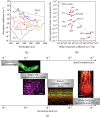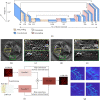Recent advances in photoacoustic tomography
- PMID: 37041754
- PMCID: PMC10085577
- DOI: 10.34133/2021/9823268
Recent advances in photoacoustic tomography
Abstract
Photoacoustic tomography (PAT) that integrates the molecular contrast of optical imaging with the high spatial resolution of ultrasound imaging in deep tissue has widespread applications in basic biological science, preclinical research and clinical trials. Recently, tremendous progress has been made in PAT regarding technical innovations, preclinical applications, and clinical translations. Here, we selectively review the recent progresses and advances in PAT, including the development of advanced PAT systems for small-animal and human imaging, newly engineered optical probes for molecular imaging, broad-spectrum PAT for label-free imaging of biological tissues, high-throughput snapshot photoacoustic topography, and integration of machine learning for image reconstruction and processing. We envision that PAT will have further technical developments and more impactful applications in biomedicine.
Conflict of interest statement
L.V.W. has financial interests in Microphotoacoustics, Inc., CalPACT, LLC, and Union Photoacoustic Technologies, Ltd., which did not support this work.
Figures










Similar articles
-
Perspective on fast-evolving photoacoustic tomography.J Biomed Opt. 2021 Jun;26(6):060602. doi: 10.1117/1.JBO.26.6.060602. J Biomed Opt. 2021. PMID: 34196136 Free PMC article.
-
Listening to tissues with new light: recent technological advances in photoacoustic imaging.J Opt. 2019 Oct;21(10):10.1088/2040-8986/ab3b1a. doi: 10.1088/2040-8986/ab3b1a. Epub 2019 Sep 9. J Opt. 2019. PMID: 32051756 Free PMC article.
-
Breakthrough in Photonics 2013: Photoacoustic Tomography in Biomedicine.IEEE Photonics J. 2014 Apr;6(2):0701006. doi: 10.1109/JPHOT.2014.2310197. IEEE Photonics J. 2014. PMID: 25383143 Free PMC article.
-
A Review of Endogenous and Exogenous Contrast Agents Used in Photoacoustic Tomography with Different Sensing Configurations.Sensors (Basel). 2020 Sep 29;20(19):5595. doi: 10.3390/s20195595. Sensors (Basel). 2020. PMID: 33003566 Free PMC article. Review.
-
Sound Out the Deep Colors: Photoacoustic Molecular Imaging at New Depths.Mol Imaging. 2020 Jan-Dec;19:1536012120981518. doi: 10.1177/1536012120981518. Mol Imaging. 2020. PMID: 33336621 Free PMC article. Review.
Cited by
-
A Closed-Loop Approach to Fight Coronavirus: Early Detection and Subsequent Treatment.Biosensors (Basel). 2022 Oct 20;12(10):900. doi: 10.3390/bios12100900. Biosensors (Basel). 2022. PMID: 36291037 Free PMC article.
-
Review of imaging test phantoms.J Biomed Opt. 2023 Aug;28(8):080903. doi: 10.1117/1.JBO.28.8.080903. Epub 2023 Aug 22. J Biomed Opt. 2023. PMID: 37614568 Free PMC article. Review.
-
Deep learning on photoacoustic tomography to remove image distortion due to inaccurate measurement of the scanning radius.Biomed Opt Express. 2023 Oct 17;14(11):5817-5832. doi: 10.1364/BOE.501277. eCollection 2023 Nov 1. Biomed Opt Express. 2023. PMID: 38021110 Free PMC article.
-
Recent advancements in molecular photoacoustic tomography.JPhys Photonics. 2025 Jul 31;7(3):032003. doi: 10.1088/2515-7647/adf167. Epub 2025 Jul 28. JPhys Photonics. 2025. PMID: 40734710 Free PMC article. Review.
-
Challenges and advances in two-dimensional photoacoustic computed tomography: a review.J Biomed Opt. 2024 Jul;29(7):070901. doi: 10.1117/1.JBO.29.7.070901. Epub 2024 Jul 12. J Biomed Opt. 2024. PMID: 39006312 Free PMC article. Review.
References
-
- Ntziachristos V., “Going deeper than microscopy: the optical imaging frontier in biology,” Nature Methods, vol. 7, no. 8, pp. 603-614, 2010 - PubMed
-
- Ntziachristos V., Ripoll J., Wang L. V., and Weissleder R., “Looking and listening to light: the evolution of whole-body photonic imaging,” Nature Biotechnology, vol. 23, no. 3, pp. 313-320, 2005 - PubMed
-
- Bell A. G., “ART. XXXIV.--On the Production and Reproduction of Sound by Light,” American Journal of Science (1880-1910), vol. 20, no. 118, p. 305, 1880
-
- Li L., Lin L., and Wang L. V., “Multiscale photoacoustic tomography,” Optics and Photonics News, vol. 29, no. 4, pp. 32-39, 2018
Grants and funding
LinkOut - more resources
Full Text Sources

